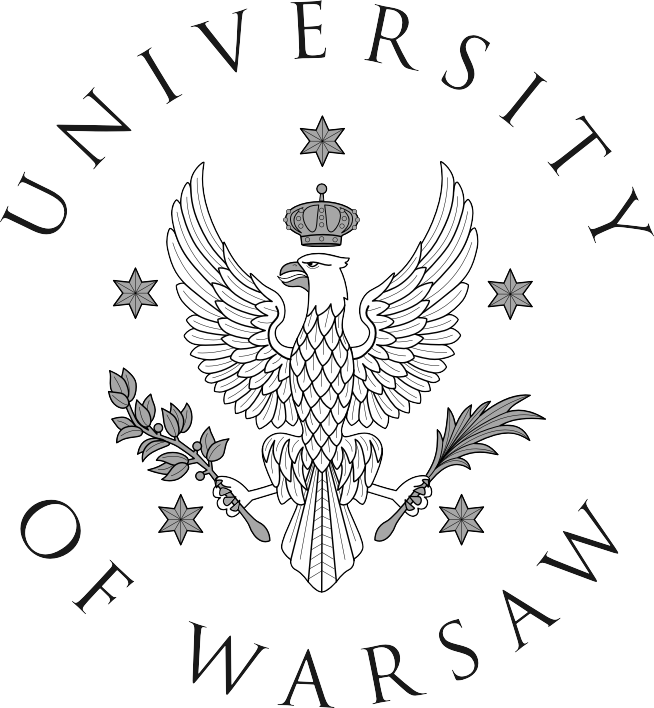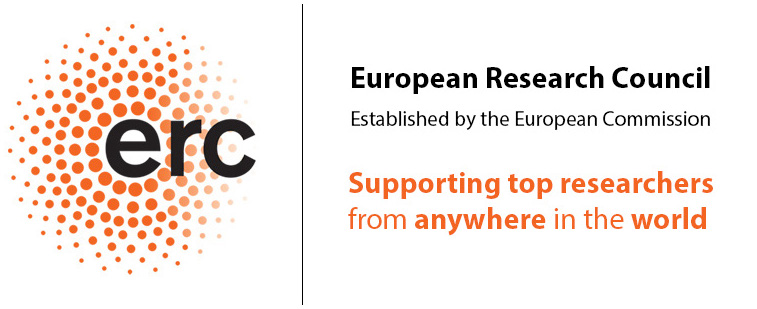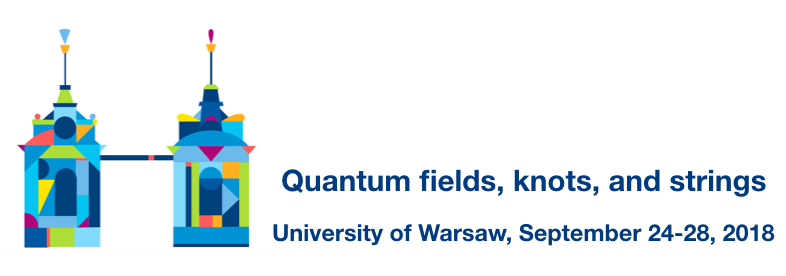
This conference is devoted to relations between quantum field theory
and string theory one hand, and mathematical knot theory and random
matrix models on the other hand. Surprising connections between these
areas of research have been found in last years. In the conference we
will summarize important recent developments in this context and try to
set the goals for the future research. Topics considered in the
conference include: supersymmetric gauge theories, BPS states,
topological string
theory, integrability, homological knot invariants, matrix models,
topological recursion.
Speakers:
Murad Alim, Maciej Borodzik, Andrea Brini, Miranda
Cheng, Tudor Dimofte, Tobias Ekholm, Stavros Garoufalidis, Sergei
Gukov, Rinat Kashaev, Albrecht Klemm, Piotr Kucharski,
Andrei Mironov, Motohico Mulase, Satoshi Nawata, Boris Pioline, Elli
Pomoni, Markus Reineke, Marko
Stošić, Cumrun Vafa, Don Zagier
Registration:
To register for the conference please write an e-mail to Petr Vasko (petr.vasko@fuw.edu.pl) before August 20,
2018, stating your name and affiliation, and arrival and
departure dates.
Some
support for travel or
accommodation for participants may be available – to apply for
it please send
a request before August 1, 2018,
to the same e-mail address (petr.vasko@fuw.edu.pl),
explaining why and what kind of support you might need. Please also let us know if
you would be interested in presenting a poster during the conference,
or whether you wish to stay at the Hera Guest House (see below).
Organizers:
Jakub Jankowski, Ehsan Hatefi, Miłosz Panfil, Piotr Sułkowski (chair),
Petr Vasko
Faculty of Physics,
University of Warsaw
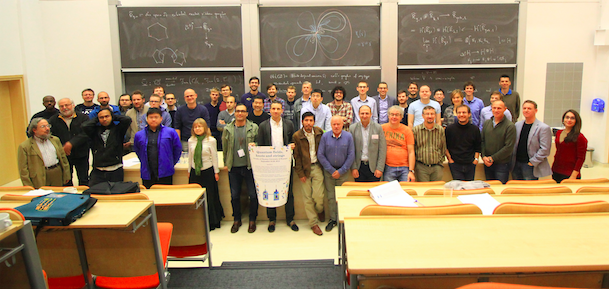
Full size photo
Special events
Public lecture
Prof. Cumrun Vafa (Harvard University)
– "Physics, Math and Puzzles" [lecture website]
September 24 (Monday), 18:00
Conference
dinner
September 26 (Wednesday), 19:00
Program
MONDAY, September 24
11:00-11:45 – Registration
11:45-12:45 – Cumrun Vafa,
"String Theory and Homological Invariants for 3-Manifolds" [slides]
12:45-14:30 – Lunch break
14:30-15:30 – Rinat Kashaev,
"The spectral problem of the modular oscillator in the strongly
coupled regime"
[slides]
15:30-16:00 – Coffee break
16:00-17:00 – Stavros Garoufalidis,
"Counting incompressible surfaces and the 3D-index"
18:00-19:30 – Public lecture: Prof. Cumrun Vafa,
"Physics, Math and Puzzles" [lecture website]
TUESDAY, September 25
8:30-9:00 – Wake-up coffee
9:00-10:00 – Maciej Borodzik, "Khovanov homotopy type and periodic links" [slides]
10:00-10:30 – Coffee break
10:30-11:30 – Boris Pioline,
"Attractor flow trees, BPS indices and quivers" [slides]
11:45-12:45 – Markus Reineke,
"BPS state algebras of quivers"
12:45-14:30 – Lunch break
14:30-15:30 – Elli Pomoni,
"Counting instantons in N=1 theories of class Sk"
[slides]
15:30-16:00 – Coffee break
16:00-17:00 – Andrea Brini,
"Chern-Simons theory and the higher genus B-model"
[slides]
WEDNESDAY, September 26
8:30-9:00 – Wake-up coffee
9:00-10:00 – Tudor Dimofte, "Categories of line operators in 3d N=4 gauge theory"
10:00-10:30 – Coffee break
10:30-11:30 – Don Zagier,
"Knots, state integrals, and the modular group"
11:45-12:45 – Tobias Ekholm,
"Open Gromov-Witten skein module invariants and large N duality"
12:45-14:30 – Lunch break
14:30-15:30 – Satoshi Nawata,
"Geometry and physics of DAHA"
15:30-16:00 – Coffee break
19:00 – Conference dinner
THURSDAY, September 27
8:30-9:00 – Wake-up coffee
9:00-10:00 – Motohico Mulase, "Ribbon graphs, Frobenius-Hopf duality, and CohFT"
10:00-10:30 – Coffee break
10:30-11:30 – Sergei Gukov,
"Logarithmic CFTs from three dimensions"
11:45-12:45 – Andrei Mironov,
"Tangles, link invariants and topological vertex"
12:45-14:30 – Lunch break
14:30-15:30 – Murad Alim,
"From tt* flat connections to parabolic Higgs bundles and opers"
15:30-16:00 – Coffee break
16:00-17:00 – Piotr Kucharski,
"Physics and geometry of knots-quivers correspondence" [slides]
FRIDAY, September 28
8:30-9:00 – Wake-up coffee
9:00-10:00 – Marko Stošić, "Knots-quivers correspondence, lattice paths, and rational knots" [slides]
10:00-10:30 – Coffee break
10:30-11:30 – Albrecht Klemm,
"Periods and quasiperiods of modular forms and D-brane masses of the quintic"
11:45-12:45 – Miranda Cheng,
"3d Modularity" [slides]
12:45-14:30 – Lunch and farewell
Abstracts
Murad Alim,
"From tt* flat connections to parabolic Higgs bundles and opers"
Abstract: I will discuss the tt* flat connection of the middle
dimensional cohomology of mirror Calabi-Yau manifolds with
one-dimensional moduli spaces. This data can be interpreted as
parabolic Higgs bundles on the sphere, where the parabolic weights are
determined from the associated variation of Hodge structure. The tt*
flat connection becomes the non-abelian Hodge flat connection and can
be shown to be gauge equivalent to a meromorphic oper in these cases.
This is based on work in progress with Florian Beck and Laura
Fredrickson.
Maciej Borodzik,
"Khovanov homotopy type and periodic links"
Abstract: Khovanov homology is an important link invariant. It assigns
to a link bigraded homology groups. Recently, Lipshitz and Sarkar
constructed a finite CW-complex, whose (co)homology is the Khovanov
homology of a link. This complex is well-defined up to stable homotopy
equivalence. It is called the Khovanov homotopy type. We show that if
the underlying link is periodic, one can define a group action on
Khovanov homotopy type. It is well defined up to stable equivariant
homotopy equivalence. Borel homology of this space is related to the
equivariant Khovanov homology defined by Politarczyk. This is a joint
project with W. Politarczyk and M. Silvero.
Andrea Brini,
"Chern-Simons theory and the higher genus B-model"
Abstract: I'll give an update on the relation of quantum invariants of
knots and 3-manifolds with higher genus mirror symmetry and the
topological recursion. For 3-manifolds, I'll give a general
realisation of quantum invariants of spherical space forms via the
Eynard-Orantin recursion on spectral curves of the relativistic Toda
system on ADE root latices. For knots, I'll outline a conjecturally
general correspondence between the coloured HOMFLY polynomial and the
topological recursion, which rests on the identification of a natural
group of piecewise linear transformations on both sides of the
correspondence.
Miranda Cheng,
"3d Modularity"
Abstract: I this talk I will discuss the unexpected appearance of
various modular-like symmetry structures in problems of 3-manifold
topology and physical 3d N=2 theories. In particular we will discuss
the role of false theta functions, mock modular forms, SL(2,Z) Weil
representations and quantum modular forms in the computation of
half-indices of the 3d theories. This talk is based on joint work with
Sungbong Chun, Francesca Ferrari, Sergei Gukov, and Sarah Harrison.
Tudor Dimofte, "Categories of line operators in 3d N=4 gauge theory"
Abstract: A 4d N=4 gauge theory (defined by a group G and a hyperkahler
G-space X) has two basic types of BPS line operators, characterized in
physical terms as Wilson lines and vortex lines. Each type acquires the
structure of a (braided tensor) category, with morphisms in the category
corresponding to spaces of local operators at a junction of lines. I will
propose a definition of these two categories, generalizing previous work of
Rozansky-Witten and Kapustin-Rozansky-Saulina; and I will discuss the
conjectured equivalences of such categories induced by three-dimensional
mirror symmetry. This is joint work with Niklas Garner, Mike Geracie,
Justin Hilburn, and Philsang Yoo. Given time, I will mention a potential
application to HOMFLY homology.
Tobias Ekholm,
"Open Gromov-Witten skein module invariants and large N duality"
Abstract: We define open Gromov-Witten invariants with values in the
skein module of a 3-dimensional Lagrangian, which in essence is an
interpretation of the boundaries of holomorphic curves as defects in
Chern-Simons theory on the brane. Together with a deformation of
complex structures known as Symplectic Field Theory stretching this
gives an explanation of large N duality. More generally, this leads
to a definition of a certain ‘universal’ open Gromov-Witten of the
cotangent bundle of any 3-dimensional manifold. The talk reports on
joint work in progress with V. Shende.
Stavros Garoufalidis,
"Counting incompressible surfaces and the 3D-index"
Abstract: I will explain some connections between the counting of
incompressible surfaces in hyperbolic 3-manifolds with boundary and the
3D index of Dimofte-Gaiotto-Gukov. Joint work with N. Dunfield, C.
Hodgson and H. Rubinstein, and, as usual, with lots of examples and
patterns.
Sergei Gukov,
"Logarithmic CFTs from three dimensions"
Abstract: In this talk I will describe a surprising structure of the new q-series
invariants of 3-manifolds – called "Zed-hat" – which play the same role
for 3-manifolds as the (colored) Jones polynomials do for knots. In
particular, I will focus on representation theory behind this
surprising structure, which will then be fully revealed in a companion
talk by Miranda Cheng. This talk is based on a joint work with Miranda
Cheng, Sungbong Chun, Francesca Ferrari, Sarah Harrison, and will use
some background material from the talk of Cumrun Vafa as a prerequisite.
Rinat Kashaev,
"The spectral problem of the modular oscillator in the strongly
coupled regime"
Abstract: Motivated by applications for non-perturbative topological strings
in toric Calabi-Yau manifolds through Grassi-Hatsuda-Mariño conjecture, I
will talk about the spectral problem for a pair of commuting modular
conjugate (in the sense of Faddeev) Harper type operators with complex
values of Planck's constant. The eigenvectors are expressed in terms of a
special entire function on the complex plane with the Taylor expansion
coefficients given in terms of specific q-orthogonal polynomials, while the
eigenvalues are solutions of transcendental Bethe type equations. This is a
joint work with Sergey Sergeev.
Albrecht Klemm,
"Periods and quasiperiods of modular forms and D-brane masses of the quintic"
Abstract: We consider one complex structure parameter mirror families
$W$ of Calabi-Yau 3-folds with Picard-Fuchs equations of hypergeometric
type. By mirror symmetry the even D-brane masses of the orginal
Calabi-Yau $M$ can be identified with four periods w.r.t. to an
integral symplectic basis of H_3(W,Z) at the point of maximal unipotent
monodromy. It was discovered by Chad Schoen in 1986 that the singular
fibre of the quintic at the conifold point gives rise to a Hecke eigen
form of weight four $f_4$ on $\Gamma_0(25)$ whose Fourier coefficients
$a_p$ are determined by counting solutions in that fibre over the
finite field $\mathbb{F}_{p^k}$. The D-brane masses at the conifold are
given by the transition matrix $T_{mc}$ between the integral symplectic
basis and a Frobenius basis at the conifold. We predict and verify to
very high precision that the entries of $T_{mc}$ relevant for the D2
and D4 brane masses are given by the two periods (or L-values) of
$f_4$. These values also determine the behaviour of the Weil-Petersson
metric and its curvature at the conifold. Moreover we describe a notion
of quasiperiods and find that the two quasi period of $f_4$ appear in
$T_{mc}$. We extend the analysis to the other hypergeometric one
parameter 3-folds and comment on simpler applications to local
Calabi-Yau 3-folds and polarized K3 surfaces.
Piotr Kucharski,
"Physics and geometry of knots-quivers correspondence"
Abstract: Recently proposed knots-quivers correspondence seems to be a
very interesting phenomenon, however very little is known about its
meaning. In this talk I would like to change it by presenting a
physical interpretation as a duality between 3d N=2 theories and
adding a geometric perspective of holomorphic disks.
Andrei Mironov,
"Tangles, link invariants and topological vertex"
Abstract: The recently suggested tangle calculus for knot and link
polynomials is intimately related to topological string considerations
and can help to build their invariants from the topological vertices.
We will discuss this interplay in the simplest example of the Hopf link
and its 2-cable. It turns out that the resolved conifold with
four different representations on the four external legs, on the
topological string side, is described by a special projection of the
four-component link L8n8, which reduces to the Hopf link colored with
two composite representations.
Motohico Mulase,
"Ribbon graphs, Frobenius-Hopf duality, and CohFT"
Abstract:
In this talk, I will outline a new formulation of CohFT utilizing
categories of ribbon graphs and their duals. First I will show that
the category of dual ribbon graphs is a universal Frobenius structure
that contains information of all Frobenius algebras. At the same time,
this category knows degeneration history of pointed algebraic curves
through ribbon graphs. The duality of surface graphs then produces a
Frobenius-Hopf duality, which is the key to the Givental-Teleman
reconstruction/classification theorem of semi-simple CohFTs. CohFT is
a theory of virtual fundamental classes of moduli spaces of stable
maps from curves into a target space X. On this fundamental class,
interactions between cohomology on the moduli of stable curves and
cohomology of X take place. Gromov-Witten invariants are correlation
functions of these interactions. Here, cohomology of the target space
forms a Frobenius algebra, and CohFT is a collection of n-point
functions on this Frobenius algebra with values in the cohomology of
moduli of stable curves. The consistency of the theory indicates that
there is a strong similarity between Frobenius algebra operations and
degeneration of curves. Our new formalism brings to us a clear picture
of this similarity through graph duality, and illustrates how this
duality implies the reconstruction theorem. The talk is based on my
joint work with Olivia Dumitrescu.
Boris Pioline,
"Attractor flow trees, BPS indices and quivers"
Abstract: Moduli spaces of quiver representations naturally appear in
physics in the context of BPS dyons in D=4, N=2 field
theories or string vacua. Based on physics intuition about BPS black
holes, I will present two formulae for computing the Poincaré
polynomial of quiver moduli spaces in terms of new invariants which do
not depend on the stability parameters. The first formula, developed in
joint work with J. Manschot and Ashoke Sen some years ago [arXiv:
1404.7154] expresses the Poincaré polynomial in terms of
recursively defined "quiver invariants", which are supposed to count
single centered black holes but whose mathematical significance is
still obscure. The second formula, inspired by the "split attractor
conjecture" in supergravity and obtained in joint work with S.
Alexandrov [arXiv: 1804.06928], expresses the same Poincaré polynomial
in terms of "attractor invariants", which are Poincaré polynomial for
subquivers for a stability condition specified by the dimension vector.
Elli Pomoni,
"Counting instantons in N=1 theories of class Sk"
Abstract: In this talk we will explain how to obtain the instanton
partition functions of a large class of N=1 superconformal theories
(SCFTs), called Sk.
We will begin by
introducing this class of N=1 SCFTs, which is obtained from Gaiotto’s
class S of N=2 SCFTs via orbifolding. We can study the Coulomb branch
of these theories by constructing and analyzing their spectral curves.
Employing our experience with the AGT correspondence we will search for
a 2D/4D relation for the N=1 SCFTs in class Sk. From the curves we can
identify the 2D CFT symmetry algebra and its representations, namely
the conformal blocks of the Virasoro/W-algebra, that underlie the 2D
theory and reproduce the spectral curves of the N = 1 SCFTs. These
conformal blocks give a prediction for the instanton partition
functions of the 4D N = 1 SCFTs of class Sk. Finally, we will present a
completely independent, elliptic genus calculation, counting open
string states on Dp/D(p-4) brane systems in type IIB string theory,
which exactly reproduces our previous result for the instanton
partition functions.
Markus Reineke,
"BPS state algebras of quivers"
Abstract: We review the definition of BPS state algebras, aka
Cohomological Hall algebras, of quivers (with stability, but without
superpotential) following M. Kontsevich and Y. Soibelman. After
stating basic properties and examples, we relate them to the geometry
of moduli spaces of stable quiver representations following joint work
with H. Franzen and S. Meinhardt, and speculate on quantum group
realizations using "exotic" R-matrices.
Marko Stošić, "Knots-quivers correspondence, lattice paths, and rational knots"
Abstract:
Knots-quivers correspondence relates the colored HOMFLY-PT invariants
of a knot with the motivic Donaldson-Thomas invariants of a
corresponding quiver. This correspondence is made completely explicit
at the level of generating series. The motivation for this relationship
comes from topological string theory, BPS (LMOV) invariants, as well as
categorification of colored HOMFLY-PT polynomials and A-polynomials.
In this talk I shall present the examples of knots-quivers
correspondence in the case of the classes of torus knots and rational
(2-bridge) links. In the particular case of torus knots this comes with
surprising applications in combinatorics involving counting of lattice
paths and number theory. One of the outcomes of this correspondence is
that from the information of the colored HOMFLY-PT polynomials of torus
knots we get novel explicit expressions for the classical combinatorial
problem of counting lattice paths under the lines with rational slopes,
as well as new integrality/divisibility properties.
In another direction, we show that all rational links satisfy
knots-quivers correspondence. Based on joint works with P. Sułkowski,
M. Reineke, P. Kucharski, M. Panfil and P. Wedrich.
Cumrun Vafa,
"String Theory and Homological Invariants for 3-Manifolds"
Abstract: I discuss how 6d superconformal theories discovered in
string theory can lead to new homological invariants for 3-manifolds.
Don Zagier,
"Knots, state integrals, and the modular group"
Abstract:
I will report on recent and ongoing work with Stavros Garoufalidis
concerning the modularity properties of the Kashaev invariant of
knots and its relationship to the asymptotic properties of various q-series arising from state integrals.
Spacetime details
Dates &
Time:
September 24-28, 2018
Venue:
Faculty of Physics, University of
Warsaw
ul. Pasteura 5, 02-093 Warsaw, Poland
Lecture hall 0.06 (ground floor)
Accommodation –
travel – practical information:
We have secured a limited
number of rooms at the Hera Guest House
(affordable, student standard) owned by the University of Warsaw (to go
from Hera to the campus, you can take the bus line 167 at the
stop “Spacerowa” and get off at “Och-Teatr,” and walk from there;
directions on jakdojade.pl and Google Maps). Another affordable hotel, a walking
distance to the campus, is Ibis Warszawa Reduta. For information about many
other hotels, how to travel to Warsaw, public transport in Warsaw,
etc., see the webpage with practical
information.
Poster
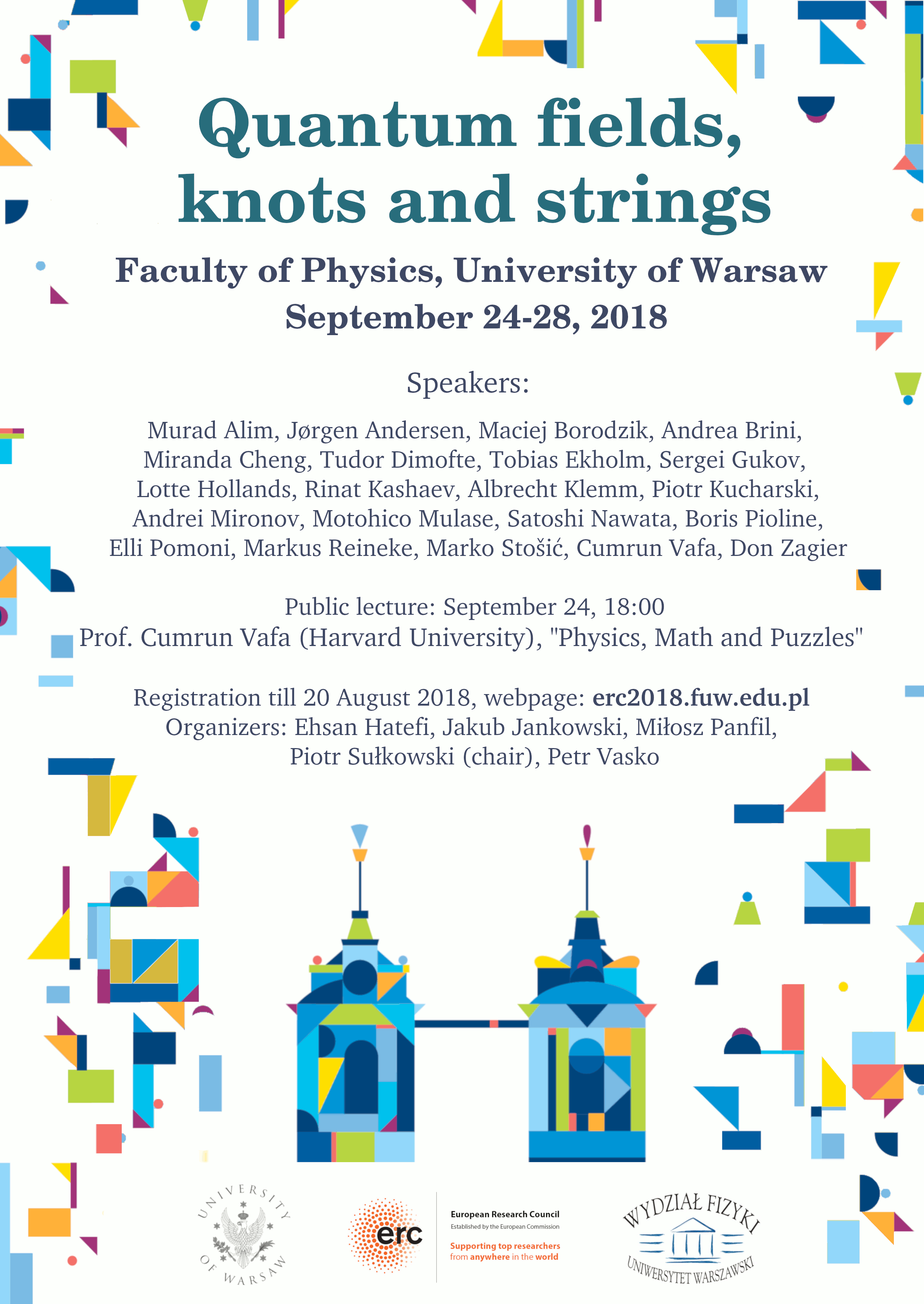
Participants
- Nezhla Aghaee (University of Bern)
- Murad Alim
(University of Hamburg)
- Alexandra
Anokhina (ITEP, Moscow)
- Anzor Beridze
(Shota Rustaveli State University, Batumi)
- Michael Bleher
(Heidelberg University)
- Agnieszka Bojanowska (University of Warsaw)
- Maciej
Borodzik (University of Warsaw)
- Andrea
Brini
(Imperial College)
- Daniel
Bryan
(University of Hamburg)
- Miranda
Cheng (University of Amsterdam)
- Sheng-Fu Chiu (Academia Sinica, Taiwan)
- Sungbong Chun (California Institute of Technology)
- Paweł
Ciosmak (University of Warsaw)
- Tudor
Dimofte (University of California Davis)
- Tobias
Ekholm (Uppsala University)
- Mirte van der Eyden (University of Amsterdam)
- Anthonny F. Canazas Garay (Pontificia Universidad Católica de Chile)
- Stavros Garoufalidis (Max Planck Institute, Bonn)
- Masoud Gharahi (University of Warsaw)
- Sergei
Gukov
(California Institute of Technology)
- Leszek Hadasz
(Jagellonian University, Kraków)
- Lukas Hahn
(Heidelberg University)
- Ehsan
Hatefi
(University of Warsaw)
- Stefan Jackowski (University of Warsaw)
- Jakub
Jankowski (University of Warsaw)
- Zbigniew Kaczmarek (Warsaw)
- Tony Kakona (ICTP)
- Marek Wojciech Kalinowski (Polish Academy of Sciences, Warsaw)
- Rinat
Kashaev (University of Geneva)
- Albrecht
Klemm (University of Bonn)
- Paweł Klimasara (University of Silesia, Katowice)
- Eren Kovanlikaya (University of Hamburg)
- Jerzy Król (University of Silesia, Katowice)
- Vadym Kurylenko (University of Hamburg)
- Piotr
Kucharski (Uppsala University)
- Adrian Langer (University of Warsaw)
- Helder
Larraguivel (University of Warsaw)
- Pietro
Longhi (Uppsala University)
- Toru Masuda (Academy of Sciences, Prague)
- Andrei
Mironov (ITEP, Moscow)
- Motohico
Mulase (University of California Davis)
- Satoshi
Nawata (Fudan University, Shanghai)
- Sebastian Nill (Heidelberg University)
- Nils Albin Nilsson (National Centre for Nuclear Research, Warsaw)
- Dmitry
Noshchenko (University of Warsaw)
- Miłosz
Panfil (University of Warsaw)
- Jacek
Pawełczyk (University of Warsaw)
- Michal Pawelkiewicz (Institut de Physique Théorique, Saclay)
- Marcin Piątek (University of Szczecin)
- Boris
Pioline (Université Pierre et Marie Curie – Paris 6 and CNRS)
- Grzegorz Plewa (National Centre for Nuclear Research, Warsaw)
- Wojciech Politarczyk (University of Warsaw)
- Elli
Pomoni
(DESY)
- Tomasz Radożycki (Cardinal Stefan Wyszyński University, Warsaw)
- Himal Rathnakumara (University of Hamburg)
- Markus
Reineke (Bochum University)
- Błażej Ruba (Jagellonian University, Kraków)
- Fabio Schlindwein (Heidelberg University)
- Marko
Stošić
(IST, Lisbon)
- Artur
Strąg
(University of Warsaw)
- Piotr
Sułkowski (University of Warsaw)
- Paweł Traczyk (University of Warsaw)
- Cumrun
Vafa
(Harvard University)
- Petr Vasko
(University of Warsaw)
- Martin Vogrin
(University of Hamburg)
- Don Zagier
(Max Planck Institute, Bonn)
- Henryk Żołądek (University of Warsaw)
Acknowledgments
